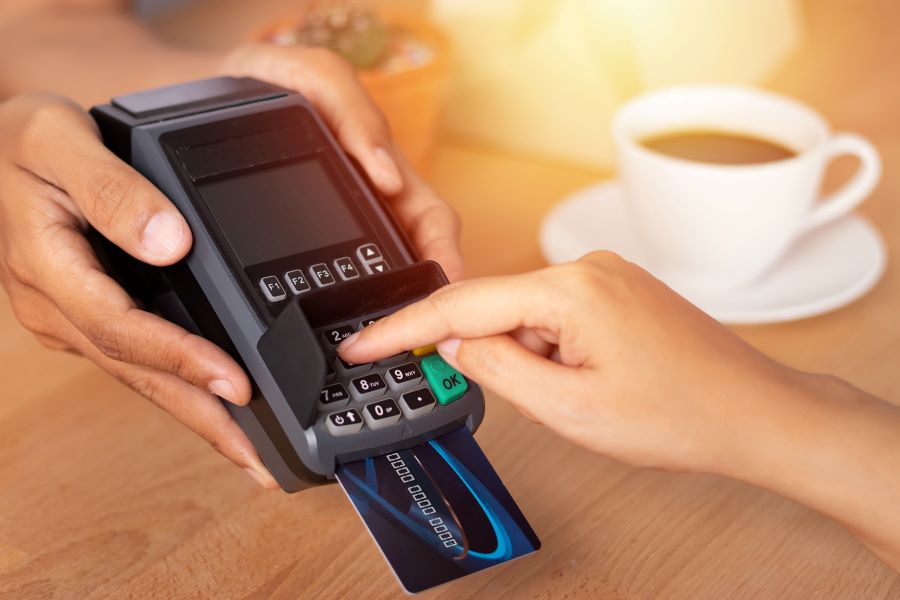Chip and PIN technology refers to the security measures implemented in debit and credit cards that require users to enter a personal identification number (PIN) during transactions. This approach replaces the traditional method of signing for purchases, providing enhanced security for both consumers and businesses.
Chip and PIN technology enable small businesses to accept various payment methods. Alongside debit and credit cards, these terminals, such as Google Pay and Apple Pay, support contactless payments. This versatility allows business owners to cater to a broader customer base, accommodating various preferred payment methods.
Chip and PIN technology integration options are diverse, with payment terminals easily integrating into existing point-of-sale (POS) systems.
What is Chip and PIN technology?
Chip and PIN technology is a secure method used for face-to-face transactions, primarily enabled by card machines or card readers. It involves using a payment terminal that reads the information from the chip embedded in the payment card. This technology adds an extra layer of security to protect against fraudulent activities.
A few simple steps are involved when paying using a Chip and PIN. First, the customer inserts their payment card into the card machine or reader. The machine then reads the information from the chip on the card containing encrypted data. The customer is prompted to enter their four-digit PIN on the machine’s keypad.
A few simple steps are involved when paying using a Chip and PIN. First, the customer inserts their payment card into the card machine or reader. The machine then reads the information from the chip on the card containing encrypted data. The customer is prompted to enter their four-digit PIN on the machine’s keypad.

The benefits of Chip and PIN technology are significant. Firstly, it enhances security by making it harder for fraudsters to replicate or steal card data. The encryption used in the chip prevents unauthorised access, reducing the risk of fraudulent transactions. Chip and PIN technology offers convenience to consumers, as it is a quick and straightforward payment method.
How does it work?
Chip and PIN, also known as EMV (Europay, Mastercard, and Visa), is a technology used in payment cards to enhance security and reduce the risk of fraudulent transactions. A microchip is embedded in the card with a chip and PIN, which stores encrypted data.
When making a payment using a chip and PIN, the customer inserts their card into a card reader or payment terminal. The card reader reads the encrypted data stored in the chip and communicates with the acquiring bank to authenticate the card. The acquiring bank then sends a request to the card issuer for verification.
Once the card is verified, the customer is prompted to enter their unique four-digit PIN on the card reader’s keypad. The PIN is securely transmitted to the card’s chip, compared with the stored PIN for verification. If the PIN matches, the transaction is approved.
This process ensures secure communication between the card, the card reader, and the acquiring bank. The encryption of transaction data prevents unauthorised access to the card’s information, making it harder for fraudsters to replicate or steal card data.
New generation Chip & PIN
The new generation Chip & PIN technology revolutionises how we make payments, offering advancements and benefits compared to older versions. This secure payment method combines a smart chip embedded in the card with a unique personal identification number (PIN), enhancing security and convenience.
One of the key advantages of the new Chip & PIN technology is its improved security features. The encrypted data stored in the chip makes it extremely challenging for fraudsters to replicate or steal card information. Additionally, the authentication process involving the acquiring bank and the card issuer adds a layer of security, reducing the risk of fraudulent transactions.
Another benefit is the speed of transactions. With Chip & PIN, payments are processed quickly and efficiently.
Payment providers like iZettle and SumUp offer apps and Chip and PIN readers for smartphones and tablets, enabling seamless card payments. This secure, affordable solution revolutionises transactions and is ideal for small businesses and service providers.

Is it right for my small business?
Small business owners have several factors to consider when deciding on the right payment method for their business. One option to consider is Chip and PIN technology, which offers a secure and efficient way for customers to make payments.
There are several benefits of using Chip and PIN technology for small businesses. Firstly, it provides improved security features, protecting the business and the customer from fraudulent transactions. The encrypted data stored in the chip makes it extremely challenging for fraudsters to replicate or steal card information. Additionally, the authentication process involving the acquiring bank and the card issuer adds an extra layer of security.
In conclusion, while Chip and PIN technology offer numerous benefits, small business owners should carefully evaluate whether it is the right payment method for their business. Considering factors such as customer preferences, potential costs, and adherence to security measures can help make an informed decision.
Frequently Asked Questions
What is Chip and PIN Technology?
Chip and PIN technology is a security standard for debit and credit card transactions, offering enhanced protection against fraudulent activities. It involves the use of a card that contains a microchip and requires the cardholder to enter a personal identification number (PIN) to complete transactions. This method is widely regarded as more secure than transactions that rely on a signature for authentication.
How Does Chip and PIN Work?
When a customer uses a Chip and PIN card for payment, the card is inserted into a card reader that reads encrypted data from the chip. The customer then securely inputs their four-digit PIN on the keypad. If the PIN entered matches the one stored in the chip, the transaction is authenticated and processed. This dual-layer of security — the chip’s encrypted data and the PIN — significantly reduces the risk of unauthorised transactions.
What Are the Benefits of Chip and PIN Technology?
- Enhanced Security: The encryption within the chip and the requirement for a PIN make it difficult for fraudsters to counterfeit or misuse the card.
- Convenience: Transactions are quick and straightforward, improving the checkout experience for customers.
- Wider Acceptance: Chip and PIN technology is widely accepted globally, making it convenient for international transactions.
- Reduction in Fraud: The adoption of Chip and PIN has been associated with a decrease in card fraud, protecting businesses and consumers alike.
Can Chip and PIN Technology Support Contactless Payments?
Yes, alongside traditional Chip and PIN transactions, many terminals that support this technology also accommodate contactless payments, such as those made with NFC-enabled devices like smartphones and contactless cards. This adds a layer of convenience, allowing customers to make small purchases quickly without entering a PIN.
Is Chip and PIN Technology Right for My Small Business?
Chip and PIN technology can be highly beneficial for small businesses due to its enhanced security features and the efficiency of the transaction process. It’s particularly suitable for businesses looking for a secure, widely accepted payment method that accommodates a variety of payment options, including contactless and mobile payments. However, it’s essential to consider your specific business needs, customer preferences, and the potential costs involved in implementing this technology.
What is the New Generation Chip & PIN?
The new generation of Chip & PIN technology introduces further advancements in security and transaction processing. These advancements include more sophisticated encryption methods and faster processing capabilities, making transactions even more secure and efficient. Payment providers now offer mobile-compatible Chip and PIN readers, enabling businesses to process payments via smartphones and tablets seamlessly.
How Can Small Businesses Implement Chip and PIN Technology?
Small businesses can implement Chip and PIN technology by acquiring a payment terminal that supports this function, often available through payment service providers like iZettle and SumUp. These providers offer user-friendly apps and card readers that integrate with smartphones and tablets, making it easy for small businesses to accept card payments securely.
What Should I Consider Before Implementing Chip and PIN for My Business?
Before implementing Chip and PIN technology, consider the following:
- Customer Preferences: Ensure your customers are comfortable using Chip and PIN for their transactions.
- Costs: Evaluate the initial setup costs and any ongoing fees associated with using Chip and PIN terminals.
- Security Measures: Familiarise yourself with the security features and compliance requirements to protect your business and customers.
Implementing Chip and PIN technology can significantly enhance the payment security and efficiency of a small business, offering a modern solution to meet customer payment preferences while minimising the risk of fraud.
Final Words
Chip and PIN technology has fundamentally transformed the landscape of secure transactions for businesses and consumers alike. By embedding a sophisticated layer of security within the payment process, it addresses critical vulnerabilities associated with traditional magnetic stripe cards and signature-based authentication. For small businesses, adopting Chip and PIN technology not only aligns with global security standards but also signals to customers a commitment to safeguarding their financial data.
The convenience and versatility offered by Chip and PIN — including its compatibility with contactless and mobile payments — cater to the evolving preferences of consumers, who increasingly value quick, secure, and flexible payment options. This technology empowers businesses to expand their customer base, streamline operations, and reduce the incidence of fraudulent transactions, thereby fostering a secure and trustworthy shopping environment.


